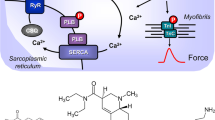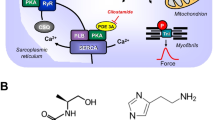Abstract
We investigated the blockade of the positive inotropic effects of 5-hydroxytryptamine (5-HT) by SB 203 186 (piperidinoethyl-indole-3-carboxylate hydrochloride) and its affinity for 5-HT4 receptors of human right atrium and piglet left atrium. We also compared the blocking effects of SB 203 186 against 5-HT-evoked tachycardia in anaesthetised adult Yucatan minipigs as well as new-born Camborough piglets.
SB 203 186 caused competitive antagonism of the positive inotropic effects of 5-HT in electrically paced atrial preparations of man (pK B = 8.9) and piglet (pK B = 8.5) at concentrations (up to 0.3 μmo]/l) which were devoid of depressant or stimulant effects. The affinity of SB 203 186 for atrial 5-HT4 receptors was 30–160 times higher than that of tropisetron. 5-HT caused tachycardia with similar potency and efficacy in Yucatan minipigs and new-born Camborough piglets. SB 203 186 (0.1–3 mg/kg, i.v.) surmountably antagonised 5-HT-evoked tachycardia in anaesthetised Yucatan minipigs or new-born Camborough piglets with similar potency. The blocking potency of SB 203 186 in Yucatan minipigs was 17 times higher than that of tropisetron. Intraduodenally administered SB 203 186 (0.3–3 mg/kg) to new-born Camborough piglets produced blockade of 5-HT-evoked tachycardia which was maximal after 20 min and lasted for more than 3 h with 0.3 mg/kg. The antagonism produced by the SB 203 186 administration in new-born Camborough piglets was dose-related and threefold greater through the intravenous route than through the intraduodenal route.
We conclude that SB 203 186 is an antagonist with nanomolar affinity for both human and porcine atrial 5-HT4 receptor. The in vivo results demonstrate that the sinoatrial 5-HT4 receptors function is similar in new-born Camborough piglets and adult Yucatan minipigs. Both porcine breeds are valid models for human atrial 5-HT4 receptors as demonstrated with the antagonist SB 203186.
Similar content being viewed by others
References
Arunlakshana O, Schild HO (1959) Some quantitative uses of drug antagonism. Br J Pharmacol Chemother 14:48–58
Blinks JR (1965) Convenient apparatus for recording contractions of isolated muscle. J Appl Physiol 20:755–757
Buchheit KH, Gamse R, Pfannnkuche H-J (1992)SDZ 205–557, a selective, surmountable antagonist for 5-HT4 receptors in the isolated guinea-pig ileum. Naunyn-Schmiedeberg's Arch Pharmacol 345:387–393
Dumuis A, Bouhelal R, Sebben M, Cory R, Bockaert J (1988) A non-classical 5-hydroxytryptamine receptor positively coupled with adenylate cyclase in the central nervous system. Mol Pharmacol 34:880–887
Dumuis A, Sebben M, Bockaert J (1989) The gastrointestinal prokinetic benzamide derivatives are agonists at the non-classical 5-HT receptor (5-HT4) positively coupled to adenylate cyclase in neurons. Naunyn-Schmiedeberg's Arch Pharmacol 340:403–10
Dumuis A, Gozlan H, Sebben M, Ansanay H, Rizzi CA, Turconi M, Monferini E, Giraldo E, Schiantarrelli P, Ladensky H, Bockaert J (1992) Characterisation of a novel serotonin (5-HT4) receptor antagonist of the azabicycloalkyl benzimidazolone class:DAU 6285. Naunyn-Schmiedeberg's Arch Pharmacol 345:264–269
Eglen RM, Alvarez R, Johnson LG, Leung E, Wong EHF (1993) The action of SDZ 205,557 at 5-hydroxytryptamine (5-HT3 and 5HT4) receptors. Br J Pharmacol 108:376–382
Gale JD, Grossman CJ, Whitehead JWF, Oxford AW, Bunce KT, Humphrey PPA (1994) GR113808: a novel, selective antagonist with high affinity at the 5-HT4 receptor. Br J Pharmacol 111:332–338
Gille E, Lemoine H, Ehle B, Kaumann AJ (1985) The affinity of (-)-propranolol for \1- and \2- adrenoceptors of human heart. Differential antagonism of the positive inotropic effects and adenylate cyclase stimulation by (-)-noradrenaline and (-)-adrenaline. Naunyn-Schmiedeberg's Arch Pharmacol 331:60–70
Grossman CJ, Gale JD, Bunce KT, Kilpatrick GJ, Whitehead JWF, Oxford AW, Humphrey PPA (1993) Development of a radioligand binding assay for the 5-HT4 receptor: use of a novel antagonist. Br J Pharmacol 108:106p
Harding SE, del Monte F, Kaumann AJ (1994)Atrial myocytes from patients taking \-blockers have increased positive inotropic responses to 5-hydroxytryptamine, Eur Heart J 15 [Suppl]: P1130
Jahnel U, Rupp J, Ertl R, Nawrath H (1992) Positive inotropic responses to 5-HT in human atrial but not in ventricular heart muscle. Naunyn-Schmiedeberg's Arch Pharmacol 346:482–485
Kaumann AJ (1990) Piglet sinoatrial 5-HT receptors resemble human atrial 5-HT4-like receptors. Naunyn-Schmiedeberg's Arch Pharmacol 342:619–622
Kaumann AJ (1993) Blockade of human atrial 5-HT4 receptors by GR 113808. Br J Pharmacol 110:1172–1174
Kaumann AJ (1994) Do human 5-HT4 receptors mediate arrhythmias? Trends Pharmacol Sci 15:451–455
Kaumann AJ, Sanders L (1994) 5-Hydroxytryptamine causes rate-dependent arrhythmias through 5-HT4 receptors in human atrium: facilitation by chronic \-adrenoceptor blockade. Naunyn-Schmiedeberg's Arch Pharmacol 349:331–337
Kaumann AJ, Sanders L, Brown AM, Murray KJ, Brown MJ (1990) A 5-hydroxytryptamine receptor in human atrium. Br J Pharmacol 100:879–885
Kaumann AJ, Sanders L, Brown AM, Murray KJ, Brown MJ (1991a) A 5-HT4-like receptor in human right atrium. Naunyn-Schmiedeberg's Arch Pharmacol 344:150–159
Kaumann AJ, Brown AM, Raval P (1991b) Putative 5-HT4-like receptors in piglet left atrium. Br J Pharmacol 102:98P
Kaumann AJ, Raval P, Medhurst A (1991c) Both siguazodan and rolipram increase positive inotropic responses to 5-hydroxytryph tamine in piglet left atria. Naunyn-Schmiedeberg's Arch Pharmacol 343: R100
Kaumann AJ, Medhurst A, Boyland P, Vimal M, Young RC (1993) SB 203186, a potent 5-HT4 receptor antagonist for cardiac 5-HT4 receptors. In: Vanhoutte PM et al. (eds) Serotonin. Kluwer, London, pp 135–139
Kaumann AJ, Gaster LM, King FD, Brown AM (1994) Blockade of human atrial 5-HT4 receptors by SB 207710, a selective and high affinity 5-HT4 receptor antagonist. Naunyn-Schmiedeberg's Arch Pharmacol 348:546–548
Kaumann AJ, Lynham JA, Brown AM (1995a) Labelling with [125I]-SB 207710 of a small 5-HT4 receptor population in piglet right atrium: functional relevance. Br J Pharmacol 115:933–936
Kaumann AJ, Lynham JA, Brown AM (1995b) [125I]-SB 207710 labels small 5-HT4 receptor populations in porcine and human atrium. Br J Pharmacol 116:39P
Lorrain J, Grosset A, O'Connor SE (1993) 5-HT4 receptors, present in piglet atria and sensitive to SDZ 205–557, are absent in papillary muscle. Eur J Pharmacol 229:105–108
Medhurst AD, Kaumann AJ (1993) Characterisation of the 5-HT4 receptor mediating tachycardia in isolated piglet right atrium. Br J Pharmacol 110:1023–1030
Ouadid H, Seguin J, Dumuis A, Bockaert J, Nargeot J (1991) Serotonin increases calcium current in human atrial myocytes via the newly described 5-hydroxytryptamine4 receptors. Mol Pharmacol 41:346–351
Parker SG, Hamburger S, Taylor EM, Kaumann AJ (1993) SB203186, a potent 5-HT4 receptor antagonist in porcine sinoatrial node and human and porcine atrium. Br J Pharmacol 108:68P
Sanders L, Kaumann AJ (1992) A 5-HT4-like receptor in human left atrium. Naunyn-Schmiedeberg's Arch Pharmacol 345: 382–386
Turconi M, Schianterelli P, Borsini F, Rizzi CA, Ladinsky H, Donetti A (1991) Azabicycloalkyl benzimidazolones: Interaction with serotonergic 5-HT3 and 5-HT4 receptors and potential therapeutic implications. Drugs of the future 16:1011–1026
Van Meel JCA, Diederen W, Haigh R, Wienen W, Pairet M, Turconi M, Doods HN (1993) The novel 5-HT4 receptor antagonist DAU 6285 antagonizes 5-hydroxytryptamine-induced tachycardia in pigs. Eur J Pharmacol 233:295–297
Villalon CM, den Boer MO, Heiligers JPC, Saxena PR (1990) Mediation of 5-hydroxytryptamine-induced tachycardia in pig by the putative 5-HT4 receptor. Br J Pharmacol 100:665–667
Villalon CM, den Boer MO, Heiligers JPC, Saxena PR (1991) Further characterisation, by use of tryptamine and benzamide derivatives, of the putative 5-HT4 receptor mediating tachycardia in the pig. Br J Pharmacol 102:107–112
Zerkowski H-R, Broede A, Kunde S, Hilleman S, Schäfer E, Vogelsang M, Michel MC, Broede O-E (1993) Comparison of the positive inotropic effects of serotonin, histamine, angiotensin II, endothelin and isoprenaline in the isolated human atrium. Naunyn-Schmiedeberg's Arch Pharmacol 347: 347–52
Author information
Authors and Affiliations
Rights and permissions
About this article
Cite this article
Parker, S.G., Taylor, E.M., Hamburger, S.A. et al. Blockade of human and porcine myocardial 5-HT4 receptors by SB 203186. Naunyn-Schmiedeberg's Arch Pharmacol 353, 28–35 (1995). https://doi.org/10.1007/BF00168912
Received:
Accepted:
Issue Date:
DOI: https://doi.org/10.1007/BF00168912




